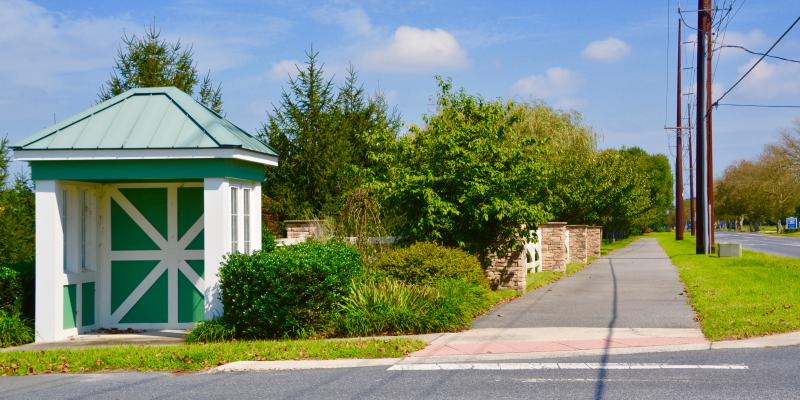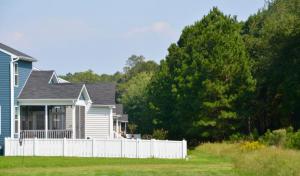Who knew 20 feet could cause so much debate.
A proposed change to Sussex County's forested/vegetated buffer ordinance brought out a large crowd of supporters and opponents during Sept. 11 and Sept. 18 county council public hearings.
Spearheaded by Councilman I.G. Burton, R-Lewes, the proposed ordinance would change the required width of a forested buffer from the current 20 feet to 40 feet around the boundary of all subdivisions of more than five lots.
Burton said he introduced the ordinance in an effort to preserve the rural character of an area.
“As development moves more into rural areas, do we want to lose that look?” he asked.
In addition, he said, an additional 20 feet would provide more space for habitat, provide a better natural view, add to pervious surface and encourage the preservation of existing trees on a property.
P&Z not in favor of ordinance
The county planning and zoning commission wants council to go back to the drawing board and gather input from stakeholders before acting on the ordinance. At its Sept. 13 meeting, the commission voted unanimously to recommend denial in its current form.
Making the motion, Commissioner Kim Hoey Stevenson said the ordinance does not address all of the possible variables including lot and property sizes, landscaping already in place, environmental issues on a parcel, types of vegetation and agricultural areas.
At the suggestion of Commissioner Keller Hopkins, the commission also urged council to hold a workshop or form a working group with stakeholders. “This is a really important matter that should not be rushed through,” Hopkins said.
“We'd be glad to work with council on this,” Hoey Stevenson said.
“And with other stakeholders as well,” said Chairman Bob Wheatley.
During council's two public hearings, besides testimony for and against the ordinance from residents, several organizations took a stand.
Two of the county's largest farmers, James Baxter IV of Georgetown and R.C. Willin of Seaford, and representatives from the Sussex County Association of Realtors, American Council of Engineering Companies, Sussex County Farm Bureau, Delaware Chapter of Associated Builders and Contractors and the Homebuilders Association of Delaware spoke in opposition to the proposed ordinance.
Representatives from the League of Women Voters of Sussex County and Sussex Alliance for Responsible Growth supported the ordinance.
Opponents said the proposed ordinance needs input from stakeholders and a working group should be created to rewrite the proposed ordinance. They said the ordinance would erode property values and cause issues for homeowners associations charged with maintaining larger buffers.
Proponents agreed with Burton that increased buffers would add value to property, preserve wooded areas and maintain an area's rural setting.
Wider buffers are needed
In support of the proposed ordinance, Sue Claire Harper, representing the League of Women Voters of Sussex County, provided a long list of benefits of preserving buffers with established, existing trees. She said trees increase property values, prevent water pollution and erosion, block noise, clean the air and provide green space.
Rich Holtkamp, representing Sussex Alliance for Responsible Growth, said passing the ordinance would give a signal that change is on the way. He said wider buffers would lead to higher development standards and not reduce the number of units on a parcel.
“Instead of remove and destroy, we need to protect and preserve,” he said.
Terry August, treasurer of the Red Fox Run HOA, said any increase in fees for buffer maintenance would be a small price to pay for privacy and environmental protection.
Gail Van Gilder of Lewes said an increase in buffer width would help farmers by providing more separation from neighboring communities. “Forty feet is minimal compared to other areas,” she said.
Karen Connelly, who lives in Redden Ridge near Rehoboth Beach, said buffers are not wide enough. “I'm trying to figure out where our 20-foot buffer is,” she said.
She said most trees in buffers are not planted properly. “The ordinance needs to reflect what works for southern Delaware, our soil and our conditions. I'm all for it with a little more specific guidelines,” she said.
Paul Reiger of Georgetown said the planning and zoning commission already has the authority to adjust the width of buffers on a site plan. “Pass the 40 feet, and it can always come back down. I can't see what the big problem is,” he said.
Seaford farmer R.C. Willin said he is a strong supporter of buffers and has maintained and managed buffers for more than 40 years. But, he said, he is concerned about the long-term implications of wider buffers with more trees and vegetation. He said few people truly understand the cost and time associated with maintaining buffers.
“They do add value, but also require a higher degree of management,” Willin said.
Ordinance needs more input
Charlie Timmons, representing the Delaware Chapter of Associated Builders and Contractors, said the proposed ordinance is long on opinions and short on facts and research. “It's not ready for a vote. You need to lessen the chance for unintended consequences,” he said.
“There is no justification to give up additional land for buffers. There is no groundswell for an extra 20 feet,” said Robert Harris, a Bethany Beach developer, who has been building homes for 30 years.
“Twenty feet is adequate, and 40 feet is much more than adequate,” he said.
He said if the additional 20 feet is taken, property owners should be compensated for the loss of the use of their land.
Sussex County Association of Realtors Executive Director Merritt Burke said the organization is opposed to the ordinance. “We'd like to be involved in a workshop to have a conversation about this,” he said.
Robert Tunnell III, of the Tunnell Companies in Long Neck, said their communities have 50-foot buffers. “We maintain miles of buffers, and I agree buffers are good, but only as good as their maintenance and upkeep,” he said.
Tunnell said requirements included in the proposed ordinance need to be re-evaluated to allow for more flexibility so they do not become a burden to homeowners' associations.
“Do it the right way and have working buffers that look good and add value,” he said.
Bobby Horsey of Laurel said property owners and farmers end up losing money. “This strongly impacts my family and our livelihoods,” he said. “I should not have to be here fighting for our property rights,” he said.
Georgetown farmer James Baxter IV said the Sussex County Farm Bureau is opposed to the ordinance. “This takes away valuable equity from the land. We do business using our land as equity,” he said.
He said if county officials want to maintain the rural look of the county, they should focus on helping farmers maintain their livelihoods, which would keep the rural look intact.

















































